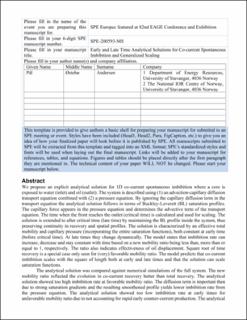| dc.description.abstract | We propose an explicit analytical solution for 1D cocurrent (COC) spontaneous imbibition (SI) in which a core is exposed to water (inlet) and oil (outlet). The system is described using an advection-capillary diffusion transport equation combined with a pressure equation. By ignoring the capillary diffusion term in the transport equation, the analytical solution follows in terms of Buckley-Leverett (BL) saturation profiles. The capillary force appears in the pressure equation and determines the advective term of the transport equation. The time when the front reaches the outlet (critical time) is calculated and used for scaling. The solution is extended to after critical time (late time) by maintaining the BL profile inside the system, thus preserving continuity in recovery and spatial profiles. The solution is characterized by an effective total mobility and capillary pressure (incorporating the entire saturation functions), both constant at early time (before critical time). At late times, they change dynamically. The model states that the imbibition rate can increase, decrease, and stay constant with time based on a new mobility ratio being less than, more than, or equal to unity, respectively. The ratio also indicates effectiveness of oil displacement. The square root of time recovery is a special case only seen for a (very) favorable mobility ratio. The model predicts that COC imbibition scales with the square of length both at early and late times and that the solution can scale saturation functions.
The analytical solution was compared against numerical simulations of the full system. The new mobility ratio reflected the evolution in COC recovery better than total recovery. The analytical solution showed a too-high imbibition rate at a favorable mobility ratio. The diffusion term is important then due to strong saturation gradients, and the resulting smoothened profile yields a lower imbibition rate from the pressure equation. The analytical solution showed a too-low imbibition rate at early times for unfavorable mobility ratio due to not accounting for rapid early countercurrent (COUC) production. The analytical solution predicted a too-high imbibition rate at late times because the BL profile does not capture the oil mobility restriction at the outlet at late times. The time of water reaching the outlet was underestimated by a factor ∼ 2 for strongly water-wet (SWW) simulations and ∼ 10 for mixed-wet (MW) simulations. Scaling recovery with length squared was exact for all times. Scaling recovery until water reaching the outlet demonstrated consistency across saturation functions and viscosities. The analytical solution could match literature experimental data and produce corresponding saturation functions.
To our knowledge, previous analytical solutions have only considered infinite-acting systems (early time), assumed piston-like displacement (PLD) (uniform saturations on both sides of a saturation shock front) or are implicit, thus not providing more insight than numerical simulations. | en_US |
